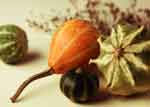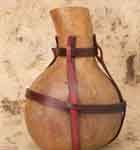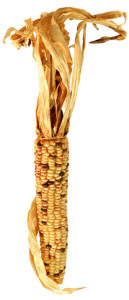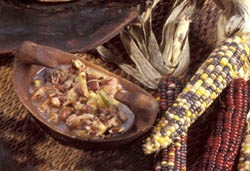See also Lenape Foods and Thanksgiving Foods There are articles & easy recipes on this page + an article on Gourds and even potato chips!
“This Thanksgiving, do not grieve the changes that have occurred in the Americas over the last five centuries; instead pray for the revival of the foods of your ancestors, and pledge to bring them back, if not for yourself, then for the next seven generations.”
By GARY NABHAN, Casa Grande Dispatch 11/24/03
Up until the last few years, if you were to try to replicate an original Native American meal served at the time of the first Thanksgiving, you would have immediately run into nearly insurmountable problems sourcing authentic ingredients derived from the animals and plants found in America at the time of the Pilgrims’ fateful landing. Not only had Native American farming traditions vanished from most of the continent, but it had become very difficult to access the very turkey breeds and heirloom seeds upon which American food traditions were founded. The hardy, flavorful Naragansett, Black Spanish and Royal Palm turkeys of our forefathers have largely been replaced by Beltsville Whites that were so over-domesticated, the modern hens required artificial insemination to ensure survival of the breed. Likewise, the colorful varieties of beans like Son-of-Star – the precursor of Great Northerns that had been handed down for generations among Mandan , Hidatsa and Arikara gardeners – were close to blinking out altogether.
Fortunately, there are many tribes as well as many non-profits that are reaching back to recover what I call “foods with true American roots” – the traditional breadstuffs that American Indian farmers, foragers and hunters have relied upon for centuries. Iroquois white corn has undergone a remarkable revival, thanks to a collaboration among the Daybreak Farming and Food Project, the Pinewoods Community, Chefs Collaborative and Bioneers. The American Livestock Breeds Conservancy and Slow Food USA have revived the propagation and marketing of five historic turkey breeds, and chefs are now paying as much of $50 a bird to serve them for this Thanksgiving. Over the last quarter century, Native Seeds/SEARCH and the Seed Savers Exchange have rescued hundreds of varieties of Native American corn, beans and squash on the verge of extinction. For years, non-profits like Native Seeds/SEARCH have supplied such seeds for free to Native American gardeners, but recently I assisted them in repatriating dozens of varieties of these historic seeds back to Hopi and Havasupai communities, where some of the crops had been originally collected between 1910 and 1950. Tribes from the Zuni and Hopi to the Iroquois Six Nations now maintain their own seed banks of such cultural treasures.
There are two good reasons why every culture native to American soil should be engaged in reviving these food traditions. First, the ceremonies, songs and stories of many tribes are inextricably linked to the planting and harvesting cycles of particular crops, and modern hybrids are no substitute for them. As one young Hopi man learned when he tried to bring store-bought baby white lima beans into the kiva, they are no match for the original mottled Hopi lima, which can be buried deep in sand and still emerge to grow prolifically. To keep our cultures, we need to keep up our agri-cultures.
Secondly, and even more urgently, these foods are desperately needed by the many individuals in Native American communities who now suffer from adult-onset diabetes, a disease virtually unknown to our elders born before 1900. The rise in diabetes on reservations is linked to the abandonment of traditional diets rich in what nutritionists call “slow release foods” – the beans, cactus fruits, camas, acorns, mesquite and roasted mescal that are slowly digested and absorbed in ways that enhance insulin sensitivity. A quarter million Native Americans in the Southwest now suffer from diabetes, and the physical, emotional and spiritual toll this disease takes on our communities is one of the great tragedies of Indian country.
A coalition of non-profits and research centers has recently formed to launch a nationwide campaign called Rescuing America’s Endangered Food Traditions. They are raising support to revitalize local fields, orchards and foraging traditions that are associated with a variety of wild and cultivated foods of this continent, from herring roe and ooligan smelt grease in Tlingit country to bird peppers and tepary beans in the lands of the Tohono O’odham spanning the Arizona-Mexico border. They are inviting tribal agricultural programs as well as boarding school gardens, elderly homes and farming co-ops in Indian country to join with them to ensure that these healthy foods live on in the lands that originally nurtured them. These, my brothers and sisters, are the lands where they are most needed today, as calories and cures, as the sources of stories and songs.
This Thanksgiving, do not grieve the changes that have occurred in the Americas over the last five centuries; instead pray for the revival of the foods of your ancestors, and pledge to bring them back, if not for yourself, then for the next seven generations.
Gary Nabhan teaches in the Applied Indigenous Studies Program at Northern Arizona University, where he also directs the Center for Sustainable Environments. He is author of numerous books, including “Coming Home to Eat” and “Enduring Seeds.” For more information about the Rescuing America’s Endangered Food Traditions Campaign, contact him at gary.nabhan@nau.edu., or consult the Web site, www.environment.nau.edu. From Shayne Del Cohen
 GOURDS – A Summer Wonder & A Fall Delight!
GOURDS – A Summer Wonder & A Fall Delight!
Do you grow gourds?
Allan grew a plant from just 1 seed, which gave him 50 bottle gourds! (I warned him, but he did not listen!!) It grew from the house to the back gate, up onto the clothes line to the house, then back to the gate! If the gate to the back alley was not there, it would still be growing. 🙂 Happy Gourding!!!
 WULAMOCAN – Gourd Most people today see gourds as pretty, decorative items that fill a bowl in the fall and help brighten up the atmosphere. They rot and you throw them in the trash. Some folks remember grandma using a dried gourd as a “sock darning kit”! Just the right size gourd was shoved in an empty sock and the hole was sewn shut. After that you walked around with a blister on your toe until you were used to the patch job. Today you can buy socks at a clearance sale for $.50 each, and the way kids wear the socks out, we are lucky!
WULAMOCAN – Gourd Most people today see gourds as pretty, decorative items that fill a bowl in the fall and help brighten up the atmosphere. They rot and you throw them in the trash. Some folks remember grandma using a dried gourd as a “sock darning kit”! Just the right size gourd was shoved in an empty sock and the hole was sewn shut. After that you walked around with a blister on your toe until you were used to the patch job. Today you can buy socks at a clearance sale for $.50 each, and the way kids wear the socks out, we are lucky!
But to the Lenape people both way back then and now, not to mention other folks too, gourds fill utilitarian needs! The Lenape people called them WULAMOCAN which also means “bottle“. Gourds were also used as dippers, bowls, rattles and, in more recent times, birdhouses and dried plant holders.
ATTENTION “GOURD-MET” COOKS
The common gourd, Lagenaria Siceraria, is really ONLY edible when the fruits are VERY young and can be used as a zucchini squash. However, we ask you NOT to try, better safe than sorry! They later become bitter, inedible, the pulp starts to “disappear” and when eaten can cause stomach aches, diarrhea, and related troubles. Stay away from the seeds too, as some contain a very strong, bitter tasting heart stimulant.
There are other gourds that are a part of the regular diet of people in Africa, India and the South Sea Islands, to name a few.
However, gourds can “grow on you”, they are great for climbing and filling space and you can turn them into something beautiful and useful. You can start a family project by growing your own “tupperware”, just like the Lenape! The variety of shapes and sizes are amazing! How about a musical instrument, a doll or a modern art sculpture?
If you are interested in growing gourds in your garden or even in a pot, contact the AMERICAN GOURD SOCIETY INC., P.O. BOX 274, MT. GILEAD, OHIO 43338. They can connect you with overseas gourd growers, tell you about their annual Gourd Festival and much more. The theme for 1989 was “The Gourd & the American Indian”.
Food for Thought: Who doesn’t enjoy potato chips?? Potatoes are from the Americas. Enjoyed bakes, cooked, mashes, French fried & as chips.
George Crum by Gaius Chamberlain George Crum was born as George Speck in 1822 in Saratoga Lake, New York, the son of a Huron Native-American mother and an African-American father who worked as a jockey. He worked for a while as a mountain guide and trapper in the Adirondack Mountains in New York. In 1853 he became the head chef at the Cary Moon’s Lake House in Lake Saratoga, New York and on one evening set out preparing the evening dinner for the guests. He intended to make french fries but a guest complained that they were too thick. Annoyed, he prepared another batch and sliced the potatoes extremely thin. After deep frying them in oil he found them very thin and very crisp and after adding salt found that the guests loved them. George began preparing the potatoes this way and they would soon become known as potato chips.
In 1860 George decided to open his own restaurant on Malta Avenue in Saratoga Lake. He featured potato chips as appetizers on each table. The restaurant was very successful and operated for 30 years, closing in 1890. Unfortunately, he never patented the potato chip, nor sought to market them outside of his restaurant. A few years after he retired, however, potato chips were mass marketed by others and would eventually become a six billion dollar a year industry.
George Crum died in 1904 at the age of 92 and left behind the legacy of creating the greatest snack food of all time.
 Corn Fritters
Corn Fritters
12 Ears of Corn, Grated Salt and Pepper to taste
6 Eggs
Separate the eggs. Beat the yolks and mix in the corn. Beat egg whites and add corn mixture to whites. Add salt and pepper to taste. Fry in hot oil in a skillet until golden brown, turning once.
This ”salsa” is very Woodland/East Coast and is delicious served with roast pork, duck , pheasant, or even chicken.
2 large, sweet apples (Macintosh or Granny Smith), cored and cut into 1-inch chunks
1 1/2 cups fresh cranberries
6 tablespoons lime juice
4 tablespoons olive oil
4 tablespoons honey
2 cups onion, chopped
1 1/2 cups bell pepper (red, yellow and/or green)
2/3 cup fresh cilantro 2 cloves garlic, minced
1 – 2 small cans chopped jalapeno 2 teaspoons salt
Fresh ground black pepper to taste
Put apples and cranberries in a food processor or blender and pulse just a bit; do not puree. Put this into a large bowl and toss with the remaining ingredients. Let sit at room temperature for 1 hour, then refrigerate for at least 12 hours. Taste and adjust the seasonings if necessary. by: Dale Carson / Indian Country Today
Indian Pudding By The Associated Press
This dense, satisfying Indian pudding developed by Kathleen Curtin, a food historian at Plimoth Plantation in Plymouth, Mass., can be baked for 90 minutes for a classic New England dessert. Or, for a 21st century shortcut to an old tradition, the final cooking can be done in the microwave in just minutes. Despite its name, Indian pudding is not a traditional Native American dish. Native Americans had neither milk nor molasses. But Indian pudding is descended from an Old World staple: hasty pudding, made from wheat flour, barley or oats, thickened with milk. Adding New World ingredients – corn, a Native American staple, and molasses, from the Caribbean sugar trade – completed the evolution of the pudding recipe into a “true American original,” Curtin says.
INDIAN PUDDING Start to finish: 2 hours (30 minutes active) Servings: 12
7 cups milk, divided
1 cup molasses
1/3 cup sugar
1/4 cup (1/2 stick) butter
2 teaspoons ginger
1 teaspoon cinnamon
3/4 teaspoon nutmeg
1 cup packed cornmeal
(Whipped cream or vanilla ice cream, to serve)
Heat the oven to 350 F. Lightly coat a 9-by-13-inch baking dish with cooking spray.
In a 6- to 8-quart Dutch oven, combine 6 cups of the milk, the molasses, sugar, butter, ginger, cinnamon and nutmeg. Place the pot over medium heat. Scald the milk by heating it until it is just about to boil. The milk will appear curdled; this is normal. In a medium bowl, mix together the remaining 1 cup of milk and the cornmeal. Whisk this mixture into the Dutch oven. Bring the mixture to a simmer and cook, stirring constantly with a rubber spatula, for 20 minutes, or until nicely thickened. Be certain to scrape the bottom of the pot to prevent sticking. Transfer the mixture to the prepared baking dish. Bake for 90 minutes, or until the pudding is set at the center. It may puff during baking, but will flatten while cooling. Let cool slightly before serving with whipped cream or vanilla ice cream.


